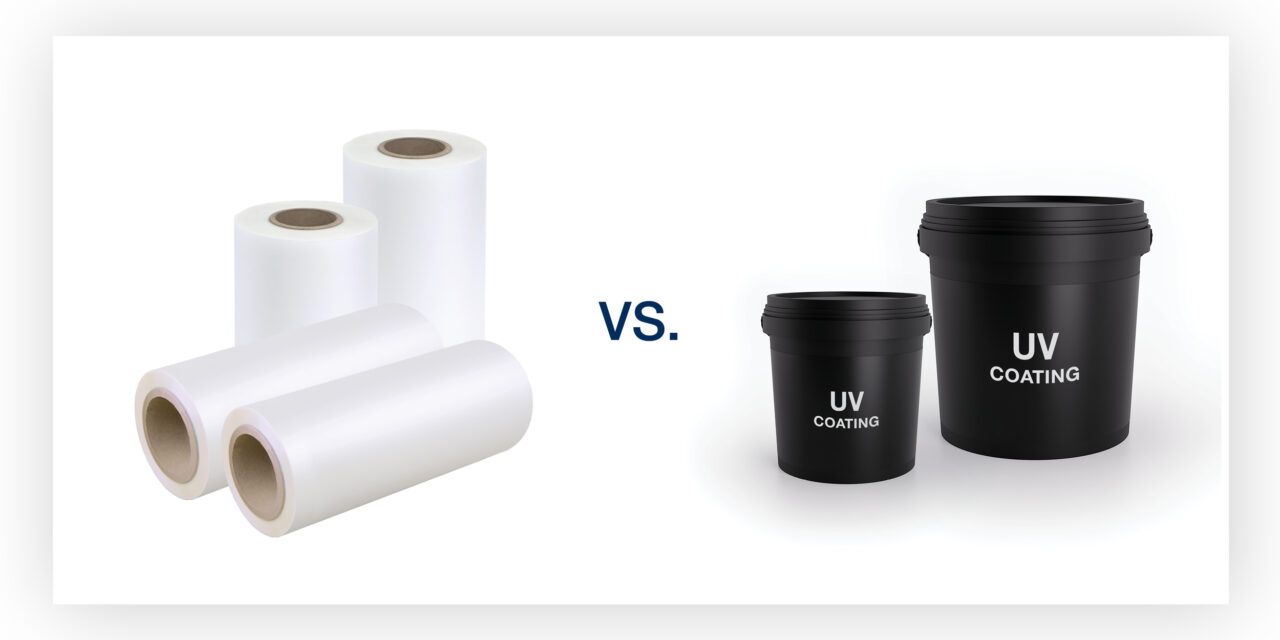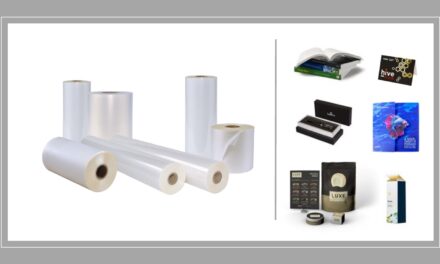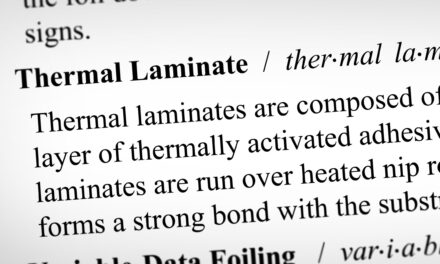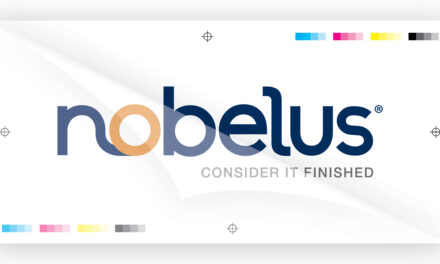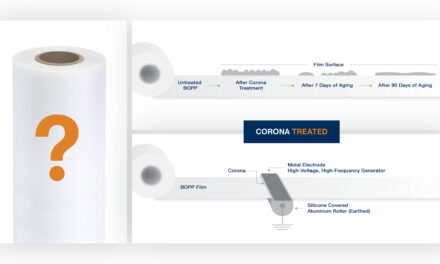ELEVATING PRINTED DESIGNS
Given all the effort that is poured into each design by the artists and printers who bring them to life, it’s only natural that the final step in any print run should be focused on protecting the printed graphic. All kinds of applications, from magazines and book covers to folding cartons and cardboard boxes, need an extra layer of protection to ensure they look pristine when they reach the customer’s hands. While there are several ways to extend the life of printed products, two very distinct methods have gained dominance in the industry: lamination and UV coating. Newcomers to printing may be curious about which method is best suited for their applications, workflow, and price point. As a supplier of laminates and laminating systems, Nobelus knows that each printer’s needs are unique and that one solution rarely fits all. To ensure each operation is equipped to meet its goals, we want to take a look at the pros and cons of each finishing method as well as when each one will be most beneficial for the printer.
WHAT IS UV COATING?
As a process, UV coating involves the application of a thick polymer resin layer over a solid surface to protect said surface from damage. In the printing industry, this polymer resin is applied in liquid form via a coating machine before being quickly cured, or dried, using ultraviolet (UV) light. Compounds used for the coating include kaolinite, polyethylene (PET), and calcium carbonate. A chemical is added to these compounds to increase the coating’s viscosity so it can form a lasting bond with the printed sheet. UV coatings can currently achieve only two types of visual effects: gloss and matte. To prevent the liquid coating from being absorbed into the substrate before it is cured, a UV coating should only be applied to coated paper stocks.
WHAT IS LAMINATION?
In general terms, lamination is the process of combining sheets of separate materials through an adhesive layer to create a new structure. When used in reference to general commercial print, lamination involves gluing a solid film layer to a printed substrate to protect both the substrate and the ink from different types of damage. Thermal laminates are films that include a thermally activated adhesive layer that is softened via a heated nip roller before being pressed against the substrate. Thermal lamination forms a strong bond immediately after the laminated sheet leaves the machine. Unsupported films, which have no thermal adhesive, are applied using a viscous adhesive that needs to be cured either through drying time or an energy-cured system.
STRENGTHS AND WEAKNESSES
Due to how different these processes are, they will each have different benefits and drawbacks that each print finisher should be aware of. Let’s look at a few major categories that may impact which finishing method is selected for a given project.
Cost
While both a laminate layer and a UV coating will inherently add value and durability to prints, both still require an additional investment in terms of equipment, time, and materials.
UV coating requires an initial equipment investment for the coating machine and regular replenishment of the chemicals used for the spray. Even though a UV coating does not increase the value of the finished piece, it’s a necessary step in ensuring the final product can adequately meet the customer’s expectations in terms of performance and protection. UV coatings can be applied and dried quickly and can be further processed immediately off the machine, which means lead times are typically short. Still, printers should be aware of several hidden costs, including labor and safety requirements, such as proper ventilation systems that protect operators from volatile organic compounds (VOCs) produced during the UV coating process. Coating lines need to be flushed out at the end of each day, which can prove time consuming and messy.
Thermal lamination has a steeper initial investment than UV coating. Finishers will need to purchase a thermal laminating system and regularly source any laminates required for their projects. Because thermal laminates include an EVA adhesive layer, they tend to be pricier than UV coatings. Despite this, laminates provide an excellent return on investment as laminated sheets can receive a variety of embellishments, which increases product value for higher revenue. Laminated sheets cool shortly after they are laminated and can be further processed immediately off the machine. Automated laminators typically cost little to nothing in terms of labor and are designed to account for any safety concerns with specialized safety features. Modern laminating systems have short warm-up times, and the act of swapping film rolls takes far less time than changing out coating lines. At the end of the day, a thermal laminator can be shut down with no cleanup necessary.
Print finishers should consider the type of applications they are producing along with their average run volumes to decide which method will be the best financial decision. In the end, the difference in cost per MSI can be a fraction of a cent. Price alone is not enough to determine which finishing process will work best for any specific workflow. The following factors will typically have a much larger effect on whether or not the chosen method maximizes an operation’s revenue potential.
Durability
Because a UV coating consists of a durable polymer resin, it will increase a printed sheet’s resistance to scratching and help keep ink from being rubbed off as the piece is handled and transported. It can also provide a moderate amount of protection from moisture. However, UV coatings may rub off with regular use, leaving behind an unappealing residue on the customer’s hands. When folded, prints that are UV coated tend to crack, becoming visually unattractive and exposing the sheet to damage. For this reason, UV coatings are typically used in applications that have a short life expectancy or are intended to serve a utilitarian purpose before being thrown away.
Lamination gives sheets a highly durable protective layer that prevents them from being damaged by dirt, grease, and moisture. Depending on the laminate’s topcoat, it may also provide complete resistance to scratching, tearing, smudging, and a host of other types of damage. For applications that require advanced durability, double-sided lamination is capable of protecting a sheet on both sides and can even completely encapsulate the print for total water resistance. Laminates will not crack when folded, making them an obvious choice for pocket folders, greeting cards, and folding cartons. Because a laminate’s thickness and material type can affect its performance in specific applications, such as polyester (PET) laminates being too rigid for folding applications, print finishers should carefully research which product will best fit their needs. To learn more about this topic, see our blog post How to Choose a Base Material for Thermal Laminating Films.
Ultimately, print finishers will need to know what degree of protection their products require to ensure their customers receive a high-quality product capable of withstanding whatever will come their way. While some applications may need only a UV coating, products made to last will benefit greatly from a laminate layer.
Image Fidelity
The vast majority of laminates are more than able to preserve the sharpness and tonality of a wide variety of designs. Gloss laminates help colors pop and give fine details, such as text and small design elements, a visual boost to help them stand out. Matte finishes can bring out the richness of dark tones and provide a soft appeal. Still, certain finishes and thicknesses may affect coloration or leave designs with a slightly muted look. In instances where color shifts occur, printers may try to adjust their press to achieve their intended results in conjunction with lamination.
Because UV coatings are relatively thin and have only two visual effects to choose from, there is little chance they will obscure or dull the printed design. The original tones and vibrancy of designs are enhanced by gloss coatings without risk of hazing or color shifts, and a matte coating will soften the design without obscuring any finer details.
On the whole, both methods will provide a similar performance in terms of image fidelity. However, print finishers who use lamination will need to validate that the specific laminate they are using can meet their desired clarity levels via a trial run before using it on a live job.
Versatility
Without a doubt, lamination provides more variety than UV coatings in terms of finishes, thicknesses, special effects, and other value-add features. While UV coatings are very limited in the effects they can produce, lamination can provide all of the same finishes along with a host of other visual effects, such as holographic patterns and shining metalized films. Additionally, laminates like our soft-touch Karess® and sandy textured FineGrit™ can be used to create a memorable haptic effect to help incentivize customers to buy items on the shelf. Other tactile finishes include FineLeather™ and FineLinen™.
Laminate finishes can do more than make a product feel luxurious. Finishes such as ScuffProof® and SmudgeProof™ supply complete, unfailing protection against scratches and smudges respectively. Cellulose (CLS) laminates like our EcoElement™ CLS can provide all the protection and durability of other laminates while reducing plastic usage for eco-conscious brands. Even the cost-effective Essentials Collection includes a robust variety of materials, including flexible polypropylene (OPP), durable polyester (PET), and breathable nylon, in different thicknesses and finishes to accommodate a range of applications.
Many laminates are also designed to receive a host of post-laminate effects, from gluing and embossing to overprinting and variable-data foiling. UV coatings may be useful in certain situations, but any print finisher who wants to diversify their offerings to truly capture the market and increase revenue will need the versatility of thermal lamination to make their mark in the industry.
HOW TO CHOOSE
Ultimately, print finishers must assess each of the considerations previously discussed and decide which finishing method is most apt to meet their needs. Traditionally, UV coatings have seen the most success with high run volumes and low demands in terms of abrasion and moisture resistance. Magazines, direct mail, and boxes are popular applications for UV coatings. However, thermal lamination will provide superior performance for folding applications, luxury goods, and any item that is at risk of damage from tearing, moisture, or oil.
Given the complex and nuanced nature of print finishing, each operation should ensure all factors are given proper consideration instead of relying simply on material cost, retail value, or even conventional wisdom to make the final decision.
WANT TO LEARN MORE?
If you have questions that weren’t covered in this post or want to have a one-on-one discussion about whether or not lamination is the right finishing method for your operation, be sure to give us a call or contact us via our website. Our dedicated solutions experts have decades of experience in the industry and can help explain the lamination process along with the different laminates and finishes we offer. Our mission is to provide the printing industry with the products and knowledge to enhance prints and create successful finishing operations.

